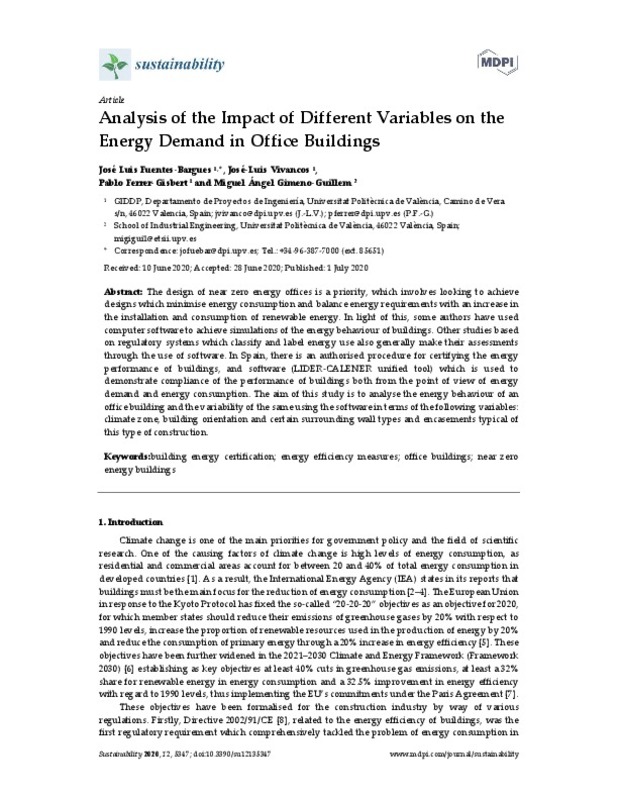Pérez-Lombard, L., Ortiz, J., & Pout, C. (2008). A review on buildings energy consumption information. Energy and Buildings, 40(3), 394-398. doi:10.1016/j.enbuild.2007.03.007
https://www.google.com.hk/url?sa=t&rct=j&q=&esrc=s&source=web&cd=&ved=2ahUKEwiD95W5-qrqAhVP62EKHaYLCFAQFjADegQIARAB&url=https%3A%2F%2Fec.europa.eu%2Fenergy%2Fsites%2Fener%2Ffiles%2Fdocuments%2F2012_energy_roadmap_2050_en_0.pdf&usg=AOvVaw3tfjm-IvZt9fXrnZuvpohw
European Comission Climate Strategies & Targets https://ec.europa.eu/clima/policies/strategies/2030_en
[+]
Pérez-Lombard, L., Ortiz, J., & Pout, C. (2008). A review on buildings energy consumption information. Energy and Buildings, 40(3), 394-398. doi:10.1016/j.enbuild.2007.03.007
https://www.google.com.hk/url?sa=t&rct=j&q=&esrc=s&source=web&cd=&ved=2ahUKEwiD95W5-qrqAhVP62EKHaYLCFAQFjADegQIARAB&url=https%3A%2F%2Fec.europa.eu%2Fenergy%2Fsites%2Fener%2Ffiles%2Fdocuments%2F2012_energy_roadmap_2050_en_0.pdf&usg=AOvVaw3tfjm-IvZt9fXrnZuvpohw
European Comission Climate Strategies & Targets https://ec.europa.eu/clima/policies/strategies/2030_en
European Comission Climate Negotations https://ec.europa.eu/clima/policies/international/negotiations/paris_en
2018/844 of the European Parliament and of the Council of 30 May 2018 Amending Directive 2010/31/EU on the Energy Performance of Buildings and Directive 2012/27/EU on Energy Efficiency https://eur-lex.europa.eu/legal-content/EN/TXT/PDF/?uri=CELEX:32018L0844&from=EN
Kurnitski, J., Saari, A., Kalamees, T., Vuolle, M., Niemelä, J., & Tark, T. (2011). Cost optimal and nearly zero (nZEB) energy performance calculations for residential buildings with REHVA definition for nZEB national implementation. Energy and Buildings, 43(11), 3279-3288. doi:10.1016/j.enbuild.2011.08.033
Aparicio Ruiz, P., Guadix Martín, J., Salmerón Lissén, J. M., & Sánchez de la Flor, F. J. (2014). An integrated optimisation method for residential building design: A case study in Spain. Energy and Buildings, 80, 158-168. doi:10.1016/j.enbuild.2014.05.020
Tourism and Digital Agenda Plan Nacional de Acción de Eficiencia Energética 2017–2020 https://ec.europa.eu/energy/sites/ener/files/documents/es_neeap_2017_es.pdf
Guía de Ahorro y Eficiencia Energética en Oficinas http://www.officinaseficientes.es/docs/guia_OFF.pdf
Crawley, D. B., Hand, J. W., Kummert, M., & Griffith, B. T. (2008). Contrasting the capabilities of building energy performance simulation programs. Building and Environment, 43(4), 661-673. doi:10.1016/j.buildenv.2006.10.027
Pérez-Andreu, V., Aparicio-Fernández, C., Martínez-Ibernón, A., & Vivancos, J.-L. (2018). Impact of climate change on heating and cooling energy demand in a residential building in a Mediterranean climate. Energy, 165, 63-74. doi:10.1016/j.energy.2018.09.015
Herrando, M., Cambra, D., Navarro, M., de la Cruz, L., Millán, G., & Zabalza, I. (2016). Energy Performance Certification of Faculty Buildings in Spain: The gap between estimated and real energy consumption. Energy Conversion and Management, 125, 141-153. doi:10.1016/j.enconman.2016.04.037
Sinacka, J., & Ratajczak, K. (2018). Analysis of selected input data impact on energy demand in office building - case study. MATEC Web of Conferences, 222, 01015. doi:10.1051/matecconf/201822201015
Mikulik, J. (2018). Energy Demand Patterns in an Office Building: A Case Study in Kraków (Southern Poland). Sustainability, 10(8), 2901. doi:10.3390/su10082901
Aparicio Ruiz, P., Sánchez de la Flor, F. J., Molina Felix, J. L., Salmerón Lissén, J., & Guadix Martín, J. (2016). Applying the HVAC systems in an integrated optimization method for residential building’s design. A case study in Spain. Energy and Buildings, 119, 74-84. doi:10.1016/j.enbuild.2016.03.023
Royal Decree 235/2013, of 5th April, Agreeing to the Procedure Basic for the Certification of the Energy Efficiency of Buildings https://www.boe.es/buscar/pdf/2013/BOE-A-2013-3904-consolidado.pdf
Unified Tool LIDER-CALENER (HULC-Tool) https://veredes.es/blog/en/herramienta-unificada-lider-calener-hulc/
Rosselló-Batle, B., Ribas, C., Moià-Pol, A., & Martínez-Moll, V. (2015). An assessment of the relationship between embodied and thermal energy demands in dwellings in a Mediterranean climate. Energy and Buildings, 109, 230-244. doi:10.1016/j.enbuild.2015.10.007
Sánchez Ramos, J., Guerrero Delgado, Mc., Álvarez Domínguez, S., Molina Félix, J. L., Sánchez de la Flor, F. J., & Tenorio Ríos, J. A. (2019). Systematic Simplified Simulation Methodology for Deep Energy Retrofitting Towards Nze Targets Using Life Cycle Energy Assessment. Energies, 12(16), 3038. doi:10.3390/en12163038
Catalogue of Constructive Elements of the TBC 2011 https://itec.cat/cec/
Construction Technology of Catalonia (Instituto de Tecnología de la Construcción: ITec) https://en.itec.cat/
Ministry of Development Support Document of the DB HE1 for the calculation of Characteristic Parameters of the Building Envelope (DA DB-HE/1) 2015 https://www.codigotecnico.org/images/stories/pdf/ahorroEnergia/DA_DB-HE-1_Calculo_de_parametros_caracteristicos_de_la_envolvente.pdf
Condiciones de Aceptación de Procedimientos Alternativos a LIDER y CALENER https://www.idae.es/publicaciones/condiciones-de-aceptacion-de-procedimientos-alternativos-lider-y-calener
Design Builder Software, ANSI/ASHRAE Standard 140-2004 Building Thermal Envelope and Fabric Load Tests 2006 http://www.designbuilder.co.uk/documents/ANSI_ASHRAE.pdf
Database 2019 https://www.five.es/productos/herramientas-on-line/visualizador-2019/
Haase, M., Marques da Silva, F., & Amato, A. (2009). Simulation of ventilated facades in hot and humid climates. Energy and Buildings, 41(4), 361-373. doi:10.1016/j.enbuild.2008.11.008
Lau, A. K. K., Salleh, E., Lim, C. H., & Sulaiman, M. Y. (2016). Potential of shading devices and glazing configurations on cooling energy savings for high-rise office buildings in hot-humid climates: The case of Malaysia. International Journal of Sustainable Built Environment, 5(2), 387-399. doi:10.1016/j.ijsbe.2016.04.004
Al-ajmi Farraj F., & Hanby, V. I. (2008). Simulation of energy consumption for Kuwaiti domestic buildings. Energy and Buildings, 40(6), 1101-1109. doi:10.1016/j.enbuild.2007.10.010
Raheem, A. A., Issa, R. R., & Olbina, S. (2013). Solar transmittance analysis of different types of sunshades in the Florida climate. Building Simulation, 7(1), 3-11. doi:10.1007/s12273-013-0137-4
Valladares-Rendón, L. G., & Lo, S.-L. (2014). Passive shading strategies to reduce outdoor insolation and indoor cooling loads by using overhang devices on a building. Building Simulation, 7(6), 671-681. doi:10.1007/s12273-014-0182-7
Huang, Y., Niu, J., & Chung, T. (2014). Comprehensive analysis on thermal and daylighting performance of glazing and shading designs on office building envelope in cooling-dominant climates. Applied Energy, 134, 215-228. doi:10.1016/j.apenergy.2014.07.100
Ng, P. K., Mithraratne, N., & Kua, H. W. (2013). Energy analysis of semi-transparent BIPV in Singapore buildings. Energy and Buildings, 66, 274-281. doi:10.1016/j.enbuild.2013.07.029
Ihara, T., Gao, T., Grynning, S., Jelle, B. P., & Gustavsen, A. (2015). Aerogel granulate glazing facades and their application potential from an energy saving perspective. Applied Energy, 142, 179-191. doi:10.1016/j.apenergy.2014.12.053
[-]









